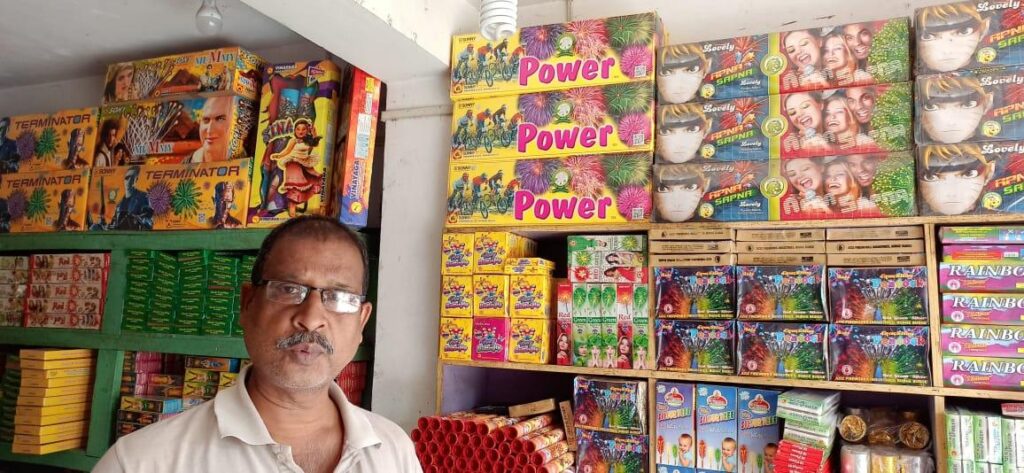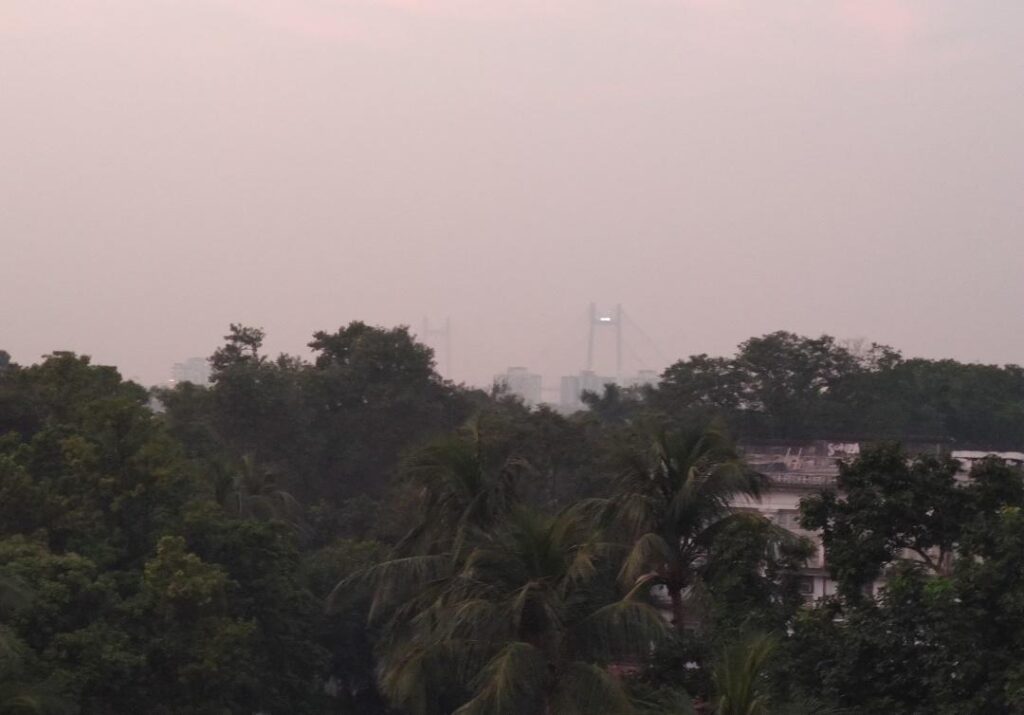Over the years, Kolkata has celebrated Diwali and Kali Puja—which fall between October to November—with religious vigor, accompanied by the carefree bursting of fireworks. The problem that looms beyond the months-long celebrations and festivities is a drop in the air quality of the city. Conventional firecrackers contain high concentrations of atmospheric pollutants, metals, charcoal, gunpowder, and other very highly toxic environmental pollutants, putting immense pressure on Kolkata’s skies.
Air pollution is emerging as one of the most pressing environmental challenges in the world’s cities and towns. Kolkata is no exception. As the 7th largest city in India housing a total population of around 14,850,000, the city is staring at rapidly deteriorating ambient air quality. Excessive fuel combustion from within the city isn’t the only factor causing this. The post-harvest season for parts of rural Bengal is in October and November, resulting in many farmers indulging in uncontrolled stubble burning. PM 2.5 concentrations in Kolkata have also been rising over the last 3 years, with even more drastic effects between the months of October to January. A nip in the air is usually felt in these months, and paired with a thick spread of smog that reduces visibility significantly.
And so, Kolkata’s air quality dips drastically with the onset of these months, reaching its lowest minimum ambient air quality. This is cause for serious concern—especially given that in 2017, outdoor air pollution caused 6% of premature deaths worldwide. Rising PM 2.5 is also directly linked to breathing more particulate matter, which correlates with a 7% and 2% increase in COVID-19 mortality respectively.
On the 5th of November, just ahead of the festive season, following multiple similar pleas from NGOs, doctor’s associations, and conscious citizens, the Calcutta High Court imposed a statewide ban on the bursting of any kind of fireworks during Diwali/Kali Puja and Chatt Puja. Stringent actions await any violation of the ban including the possibility of six month’s jail term. The effects of the ban were successful: Kolkata witnessed one of its cleanest Diwali seasons in years.
#SayNoToCrackers
Happy Diwali..
Our city as on tonight …@CPKolkata @KolkataPolice pic.twitter.com/jKhdqaTKis— DCP Central Kolkata (@KPCentralDiv) November 14, 2020
The issue that looms over our heads now is the need for a long-term solution for an issue that is simply going to get worse over the years if immediate action isn’t taken. However, the issue of reducing public dependence on toxic firecrackers is a difficult one: one that requires an overwhelming change in public habits. An alternative is already available, employed in areas like the NCR and Punjab: switching to NEERI certified CSIR green fire-crackers.
Changing Habits: Is There a Market for Green Alternatives?
Green firecrackers, containing the distinct, green logo of CSIR-NEERI and PESO, and a Quick Response (QR) code on their packaging, are “green” or eco-friendly because they contain reduced levels of sulphur and black powder, and safe levels (30-40%) of barium, aluminium, and thermite. Coupled with that, green crackers emit water vapour and air which act as dust suppressants, leading to a 30-40% reduction in emissions compared to conventional firecrackers. “As concerned citizens, we have urged the government to ban firecrackers in cities where the air quality is not satisfactory,” says Vinay Jaju, the co-founder of SwitchON Foundation, Kolkata. “However, alternatives could be the adoption of green firecrackers in areas of satisfactory air quality and for limited periods of time.”
The question now is: how do you gauge public sentiment towards purchasing these eco-friendlier alternatives?
Taking action ahead of the curve to answer this question, a consortium of medical professionals, school students, city-based youth climate activists, NGOs, and other stakeholders, have come together to form the Bengal Clean Air Network (Bengal-CAN), an initiative of SwitchON Foundation, Kolkata. Formed in October of this year, Bengal-CAN aims to take action against Kolkata’s deteriorating air quality and its impacts on the health of the city dwellers, especially as the city battles a deadly health crisis. Under the aegis of the initiative, highly accurate air monitors were set up across several non-attainment cities in West Bengal—or cities that have not met the National Ambient Air Quality Standards (NAAQS) for more than five years—to monitor the air quality over time and engage in policy advocacy for clean air across an airshed in Bengal.

A study carried out by the BengalCAN Network across 23 fireworks sellers and 677 citizens to understand the market demand for green firecrackers offers some answers to our questions on green firecrackers. Only 35% of those surveyed were in favour of a complete ban on firecrackers, because they didn’t want the government to disturb the festive traditions of bursting firecrackers during Diwali and Kali Puja. More worryingly, only 19% of the sample, even knew how to correctly identify certified green firecrackers!
This has worrying implications for those merchants selling green firecrackers, or those hesitant to make the switch—the study noted that for 80% of the firecracker sellers, less than 25% stocked green firecrackers. The hastily announced ban—which could have been notified well in advance—only made matters worse for sellers who’d invested huge sums in the commodities.
“Green fire-crackers are still not popular among consumers due to a lack of awareness, and their scarcity in the market,” says Amal Nath, a fire-cracker seller in Kolkata’s Nungi Bazaar, the largest firecracker market in West Bengal. Slow sales for these alternatives only add insult to injury for an industry hit by the COVID-19 pandemic. Says Nath, “Only 10-12% of the total firework stock has been sold this year. If the government bans the sale of fireworks entirely, all artisans who make these fireworks in the villages will go through extreme hardships.” He adds, “If the government can support us in switching to green firecrackers entirely or train us to make sustainable Diwali products, rather than completely sweeping away our business, that would be very helpful.”
Moving Ahead
“We need to be mindful of the livelihoods of the artisans involved in making firecrackers,” says Jaju. Although not a panacea to the crisis, generating alternative sources of income through green firecrackers can be a step forward. Even in spite of the current woes faced by the green firecracker market, the news isn’t all negative. About 64% of the citizens surveyed expressed their willingness to pay a higher price to buy green firecrackers, considering the state of Kolkata’s air quality.
However, the bottom line is that while the firecracker industry has suffered a huge setback with the statewide ban, the problem of rapidly degrading air quality affects not just Kolkata, but the whole state. There is still a pressing need to advocate policies for greener alternatives to maintain the state’s air quality while also securing lakhs of peoples’ livelihoods.

A graded approach can be adopted at the state-level, wherein a deadly environmental crisis like air pollution is addressed in a livelihood-centric way, one that offers livelihood alternatives and raises public awareness on the need to shift our behaviours. Some of these initiatives could include limiting the market demand for conventional firecrackers through restrictions, and instead promoting handmade traditional diyas, lanterns, and Diwali lights made from clay. They could also involve training artisans on how to make low emission fireworks, lanterns, and illuminated decorations. Artisans can also be engaged in the production of LED lights—most of which are often imported from China. Above all, if firecracker bans constitute the future, they need to be announced in time for sellers and producers to avoid the hardships they currently face.
Featured photograph by SwitchON Foundation.






